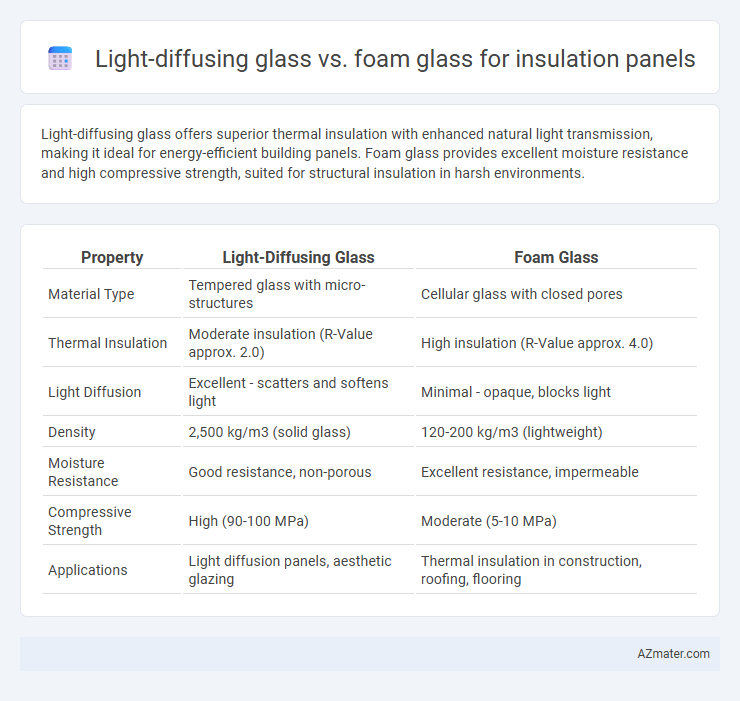Light-diffusing glass offers superior thermal insulation with enhanced natural light transmission, making it ideal for energy-efficient building panels. Foam glass provides excellent moisture resistance and high compressive strength, suited for structural insulation in harsh environments.
Table of Comparison
| Property | Light-Diffusing Glass | Foam Glass |
|---|---|---|
| Material Type | Tempered glass with micro-structures | Cellular glass with closed pores |
| Thermal Insulation | Moderate insulation (R-Value approx. 2.0) | High insulation (R-Value approx. 4.0) |
| Light Diffusion | Excellent - scatters and softens light | Minimal - opaque, blocks light |
| Density | 2,500 kg/m3 (solid glass) | 120-200 kg/m3 (lightweight) |
| Moisture Resistance | Good resistance, non-porous | Excellent resistance, impermeable |
| Compressive Strength | High (90-100 MPa) | Moderate (5-10 MPa) |
| Applications | Light diffusion panels, aesthetic glazing | Thermal insulation in construction, roofing, flooring |
Introduction to Advanced Insulation Materials
Light-diffusing glass enhances thermal performance by scattering light to reduce heat transmission while maintaining transparency, making it ideal for energy-efficient buildings. Foam glass insulation panels offer superior thermal resistance, vapor tightness, and compressive strength due to their closed-cell structure formed from recycled glass. Both materials represent advanced insulation solutions that improve energy efficiency and sustainability in modern construction.
What is Light-Diffusing Glass?
Light-diffusing glass is a specialized material designed to scatter and evenly distribute light, improving illumination quality and reducing glare in insulation panels. Unlike foam glass, which primarily offers thermal insulation through its cellular structure, light-diffusing glass optimizes natural and artificial light transmission while maintaining thermal performance. Its unique microstructure enhances energy efficiency and visual comfort in building applications by balancing light diffusion and insulation properties.
What is Foam Glass?
Foam glass is a lightweight, durable insulation material made from recycled glass, characterized by its closed-cell structure that provides excellent thermal insulation and moisture resistance. Unlike light-diffusing glass, which is designed to scatter light for enhanced illumination, foam glass focuses primarily on thermal performance and structural stability in insulation panels. Its high compressive strength and fire resistance make foam glass ideal for insulating foundations, roofs, and industrial applications where both insulation and durability are critical.
Thermal Performance Comparison
Light-diffusing glass insulation panels offer superior thermal performance with higher transparency to natural light while maintaining effective heat resistance, making them ideal for energy-efficient building envelopes. Foam glass insulation panels provide excellent thermal insulation through closed-cell structure and low thermal conductivity, ensuring strong moisture resistance and durability in extreme conditions. Comparing thermal resistance values, foam glass typically exhibits lower thermal conductivity (around 0.038 W/m*K) compared to light-diffusing glass, enhancing its insulating efficiency in applications requiring robust thermal barriers.
Energy Efficiency and Insulation Values
Light-diffusing glass insulation panels offer superior thermal performance by evenly distributing natural light while reducing heat loss, resulting in enhanced energy efficiency for buildings. Foam glass insulation panels provide excellent R-values, typically around R-4 to R-5 per inch, and feature high compressive strength and moisture resistance, which contribute to maintaining consistent insulation properties over time. Comparing both, light-diffusing glass excels in integrating daylight control with insulation, whereas foam glass delivers robust thermal resistance and durability, making each suitable for specific energy-saving applications.
Moisture Resistance and Durability
Light-diffusing glass insulation panels exhibit superior moisture resistance due to their non-porous surface, preventing water absorption and mold growth, which enhances longevity in humid environments. Foam glass insulation panels also offer excellent durability and moisture resistance, as their closed-cell structure provides waterproofing and resistance to chemical damage. When comparing both, light-diffusing glass excels in consistent moisture barrier performance, while foam glass offers enhanced impact resistance and thermal stability for long-term insulation applications.
Environmental Impact and Sustainability
Light-diffusing glass insulation panels enhance natural lighting, reducing energy consumption and carbon emissions associated with artificial lighting, while their recyclability minimizes environmental waste. Foam glass insulation offers superior thermal resistance, is made from recycled glass cullet, and is fully recyclable, contributing to reduced landfill impact and resource preservation. Both materials promote sustainable building practices by improving energy efficiency and supporting circular economy principles through effective recycling capabilities.
Aesthetic and Functional Differences
Light-diffusing glass insulation panels offer superior aesthetic appeal through their translucent properties, allowing natural light to permeate while maintaining privacy and visual softness. Foam glass insulation panels provide a solid, opaque appearance with high compressive strength and excellent thermal insulation, ideal for environments requiring robust durability and moisture resistance. Functionally, light-diffusing glass enhances interior ambiance by softening light diffusion, whereas foam glass excels in structural support and long-term insulation performance under harsh conditions.
Installation Challenges and Considerations
Light-diffusing glass panels offer superior aesthetic appeal and enhanced natural light distribution but require meticulous handling and precise alignment during installation to avoid damage and ensure uniform light diffusion. Foam glass insulation panels provide excellent thermal resistance and moisture impermeability but demand careful surface preparation and secure fastening to accommodate their rigidity and prevent structural shifts. Selecting between them involves assessing the trade-offs in installation complexity, durability, and performance characteristics specific to the project environment.
Application Suitability: Choosing the Right Material
Light-diffusing glass excels in applications requiring uniform illumination combined with thermal insulation, making it ideal for skylights, LED panel covers, and architectural glazing. Foam glass offers superior compressive strength, moisture resistance, and fireproof properties, making it suitable for industrial insulation, roofing, and foundation insulation where structural support and durability are critical. Selecting the right material depends on balancing light transmission needs with mechanical strength and environmental exposure in specific insulation panel applications.

Infographic: Light-diffusing glass vs Foam glass for Insulation panel
 azmater.com
azmater.com